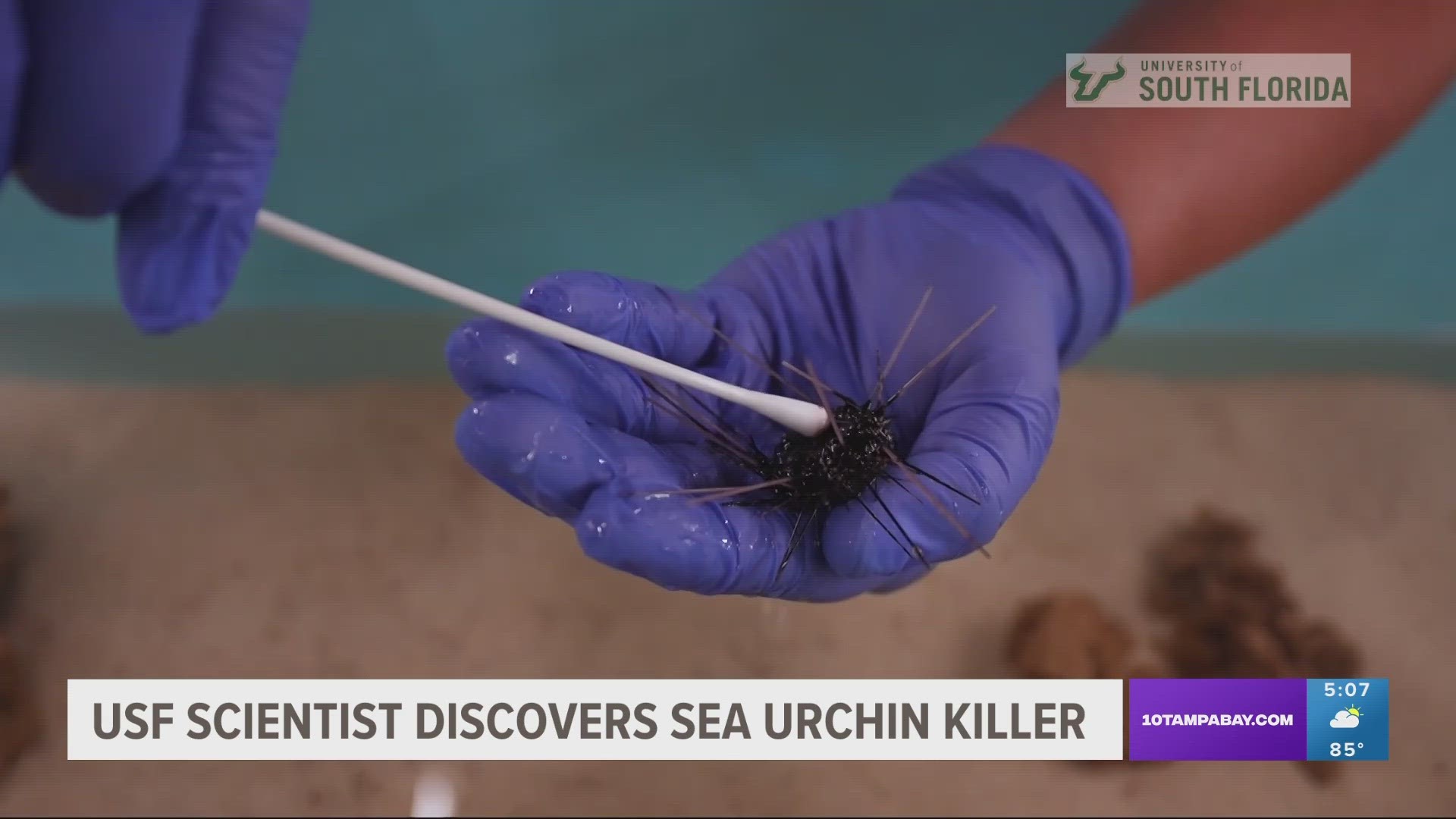ST. PETERSBURG, Fla. — If you've gone snorkeling or visited the touch tank at your local aquarium, you've likely seen a sea urchin. The black, spiny creatures play a critical role to the health of coral reefs.
In 2022, there was a mass mortality event, killing nearly every urchin in impacted areas along the U.S. Virgin Islands and stretched for thousands of miles between the Caribbean and the east coast of Florida.
When that happened, scientists began the search for why. Sea urchins would lose their spines, then in a matter of days, they'd die.
Mya Breitbart is a distinguished professor at USF's College of Marine Science. When she got the call asking for her help in March of 2022, she didn't hesitate.
"That was a very quick yes, for me, in general, because I love investigating marine life in general, and I'm very passionate about preventing disease and outbreaks," Breitbart said.
She assembled a small team and got to work. That team was comprised of Ian Hewson, the first author on the publication who is a professor and marine ecologist at Cornell University; Christina Kellogg, a microbiologist from the USGS in St. Petersburg; and USF graduate student Isabella Ritchie.
Through research, testing, and data analysis, Breitbart inched closer to her answer.
"We kind of have to take this broad approach because we really didn't know what we were looking for in those sequences," Breitbart said. "What really stood out to us was a ciliate called the scuticociliate. And that's a known pathogen of marine organisms. And we only found it in the sick versions. And so that was one of those very tantalizing, wow, this could be something right here."
A ciliate is a single-celled organism. They get their name because they are covered in cilia, hair-like structures that allow them to move and eat. They're not uncommon, found just about anywhere there's water. But most of them don't cause diseases like what is responsible for killing off sea urchins. The ciliate doing the damage here is called a scuticociliate.
It was the answer Breitbart had been searching for.
"This was a very large-scale event," she said. "While it was first observed in the US Virgin Islands at the end of January of 2022, by March, April and kind of throughout the summer, it was really spreading widely throughout the Caribbean covering over 1000 miles and it did reach the Florida Keys, which was actually where we were able to isolate the ciliate from in the affected populations.
"We estimate that about 95 to 98% of the urchins at a given site died. So if you think about 100, urchins to start with, only two of them probably survived this event. And these numbers were already pretty low compared to historical times, because of the large die-off that had happened about 40 years ago."
Breitbart tested if ciliates were indeed the culprit. There were two groups of urchins; one group was exposed to ciliates, the other was the control.
"As we were watching that process, we were collecting any spines that were dropped, and then as it became clear the urchins were dying," Breitbart said. "And then for the controls which remained healthy throughout the experiment."
Not only are the research findings in solving the sea urchin mass mortality event impressive, but the timeline in which they did it is even more so. It took researchers just four months.
"It often takes years, decades, and sometimes never gets figured out what's behind these diseases," Breitbart said. "this has never happened in my career before. And I think of you talk to anybody kind of working in the marine disease realm, this is very rare to be able to so quickly identify a pathogen and then to actually be able to culture it, have it in the lab to work with and perform experiments, is completely unprecedented."
You may wonder why these spiny invertebrates and this research is so important.
"Urchins are so such an important part of the coral reef ecosystem," Kellogg explained. "So they're sort of the lawnmowers that keep the algae from overgrowing all the surfaces. And that way, there's free spaces available for the corals to land and grow. And so anything that removes the few urchins we have left after the massive die-off in the 1980s, is really important because it can change the actual ecosystem."
Sea urchin populations are still recovering following a die-off event that occurred in the 1980s. 98 percent of sea urchins were wiped out. The cause of the 1980 die-off has yet to be determined.
"Being able to quickly treat this, since it is still going on, would allow us to preserve the urchins and try and maintain that balance in the reef," Kellogg said.
Right now-- research is being done to find ways to treat ciliates.
Malique Rankin is a general assignment reporter with 10 Tampa Bay. You can email her story ideas at mrankin@10tampabay.com and follow her Facebook, Twitter, and Instagram pages.

